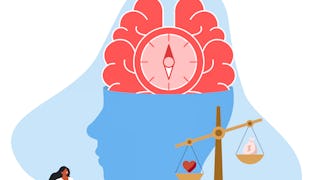This course examines how ethical decision-making unfolds at the intersection of law and psychology. Drawing on real-life legal casesand a host of classic psychological experiments, we explore how cognitive biases such as loss aversion, status quo bias, and framing effects can complicate even the most straightforward moral choices. You’ll explore how our natural tendency to focus on what is most salient in any given situation can skew risk assessments, and how motivated reasoning and self-serving biases may subtly warp our judgments, whether in the boardroom, the courtroom, or everyday life. Finally, we round out our investigation with practical tools—like decision matrices—that empower you to break down complex decisions into their component parts, ensuring that your choices not only reflect your core values but also withstand rigorous, objective scrutiny.



Money, Risk, and Ethics: The Psychology of Decision-Making

Instructor: Tess Wilkinson-Ryan
Access provided by Coursera Learning Team
Details to know

Add to your LinkedIn profile
1 assignment
March 2025
See how employees at top companies are mastering in-demand skills


Earn a career certificate
Add this credential to your LinkedIn profile, resume, or CV
Share it on social media and in your performance review

There are 4 modules in this course
In this module, students will learn the foundational concepts at the intersection of ethical decision-making and psychology. Through analysis of real-life legal cases and controlled experiments, learners will discover how cognitive biases and framing effects—such as loss aversion, status quo bias, and the endowment effect—influence moral reasoning and judgment. The lectures unpack the complexities of ethical dilemmas by examining how contextual factors, numerical framing, and underlying psychological mechanisms shape our decisions in both personal and professional settings. By engaging with classic studies like the dictator game, the bully game, and landmark legal cases, students will gain a nuanced understanding of how ethical and moral choices are systematically influenced by human psychology.
What's included
9 videos3 discussion prompts
In Module 2, we introduce the role of salience and cognitive biases in ethical decision-making. We will examine how our attention is involuntarily drawn to specific stimuli, ranging from sensory cutes to vivid memories, and how this selective focus shapes our judgments. We will explore concepts such as the availability heuristic, hindsight bias, and anchoring effects, as well as how motivated reasoning and confirmation bias can distort our evaluation of risks and moral choices. By analyzing classic developmental tests like the Sally-Anne task alongside real-world examples in legal, financial, and everyday contexts, learners will gain insight into how salience influences what we notice, remember, and ultimately decide.
What's included
9 videos3 discussion prompts
Module 3 focuses on the pervasive influence of motivated reasoning and self-serving biases in ethical decision-making. We will examine how preexisting beliefs shape the intake of new evidence and how individuals tend to favor information that confirms their desired conclusions. Through a series of experiments and real-world examples, learners will explore phenomena such as the self-serving bias, confirmation bias, and the just world hypothesis. The module culminates with practical strategies, such as “consider the opposite” and accountability interventions, that help mitigate these biases and promote more objective, value-aligned decision-making.
What's included
5 videos3 discussion prompts
Module 4 introduces the decision matrix as a systematic tool for multi-attribute decision making. By breaking down complex, holistic judgments into discrete, measurable components, this module demonstrates how to disaggregate factors such as teamwork, sales performance, reliability, and leadership potential in managerial and hiring contexts. Students will learn how to assign appropriate weights to different attributes, aggregate granular judgments mechanically, and reduce the influence of salience and bias. Ultimately, the module equips learners with strategies to align decisions more closely with their organizational values and ethical priorities.
What's included
3 videos1 assignment1 discussion prompt
Instructor

Offered by
Why people choose Coursera for their career




Recommended if you're interested in Business

University of Pennsylvania

American Psychological Association

University of Lausanne

Northeastern University

Open new doors with Coursera Plus
Unlimited access to 10,000+ world-class courses, hands-on projects, and job-ready certificate programs - all included in your subscription
Advance your career with an online degree
Earn a degree from world-class universities - 100% online
Join over 3,400 global companies that choose Coursera for Business
Upskill your employees to excel in the digital economy


